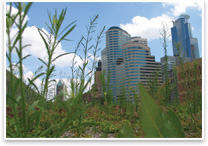Green Roofs Can Save Energy, Money
Summary: InformeDesign®, the
first searchable database of design and human behavior research on
the Web, recently released a new issue of its monthly newsletter, Implications, which
presents an article by landscape architect L. Peter MacDonagh that
investigates green roofs’ potential savings in materials and
money, thanks to their long lives and insulating abilities.
 Although the technology for present-day green roofs was developed in Germany about 30 years ago and is used throughout Europe today, green roofs have only recently attracted attention in the U.S., notes MacDonagh, the cofounder of The Kestrel Design Group Inc. and a member of the University of Minnesota’s College of Design landscape architecture faculty. “Green roofs make sense, both in ecological and economic terms,” he wrote. The initial cost of a green roof can be up to twice that of a conventional roof, but the life expectancy of a green roof is about three times that of a conventional roof. In addition, green roofs have excellent insulating qualities and thus help reduce energy costs. Although the technology for present-day green roofs was developed in Germany about 30 years ago and is used throughout Europe today, green roofs have only recently attracted attention in the U.S., notes MacDonagh, the cofounder of The Kestrel Design Group Inc. and a member of the University of Minnesota’s College of Design landscape architecture faculty. “Green roofs make sense, both in ecological and economic terms,” he wrote. The initial cost of a green roof can be up to twice that of a conventional roof, but the life expectancy of a green roof is about three times that of a conventional roof. In addition, green roofs have excellent insulating qualities and thus help reduce energy costs.
In addition to economic benefits, MacDonagh notes, green roofs offer
the advantages of storm-water management and air quality, thermal,
noise insulation, social, psychological, and economic benefits.
Article offers sidebar on teaching design
The article also offers a sidebar in which Roger B. Martin, FASLA, discusses teaching design processes. Martin—whose landscape-architect career includes 20 years of teaching at the University of Minnesota and University of California, Berkeley—says that design thinking skills, crucial to the practice of landscape architecture and other design professions, can and should be taught. Techniques such as switching between verbal and visual expressions of the problem help to strengthen, extend, and internalize the designer’s repertoire of creative approaches. “The ability to call on these process skills effortlessly is essential to future creative design professionals,” says Martin. “Teaching design process frees up the designer to deal with the complexity of built projects later.”
Useful database offers hundreds of business and practice tips
InformeDesign offers more than 1,500 “practitioner-friendly” research
summaries gleaned from more than 160 scholarly journals related to
design and human behavior. All services on the InformeDesign Web
site—which include a calendar of research-related events and
a glossary of terms—are available at no cost. Visitors also
may register to receive automated e-mail notifications about research
summaries in their areas of choice. For more information, visit
InformeDesign’s Web site.
|


 Although the technology for present-day green roofs was developed in Germany about 30 years ago and is used throughout Europe today, green roofs have only recently attracted attention in the U.S., notes MacDonagh, the cofounder of The Kestrel Design Group Inc. and a member of the University of Minnesota’s College of Design landscape architecture faculty. “Green roofs make sense, both in ecological and economic terms,” he wrote. The initial cost of a green roof can be up to twice that of a conventional roof, but the life expectancy of a green roof is about three times that of a conventional roof. In addition, green roofs have excellent insulating qualities and thus help reduce energy costs.
Although the technology for present-day green roofs was developed in Germany about 30 years ago and is used throughout Europe today, green roofs have only recently attracted attention in the U.S., notes MacDonagh, the cofounder of The Kestrel Design Group Inc. and a member of the University of Minnesota’s College of Design landscape architecture faculty. “Green roofs make sense, both in ecological and economic terms,” he wrote. The initial cost of a green roof can be up to twice that of a conventional roof, but the life expectancy of a green roof is about three times that of a conventional roof. In addition, green roofs have excellent insulating qualities and thus help reduce energy costs.